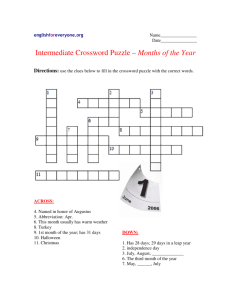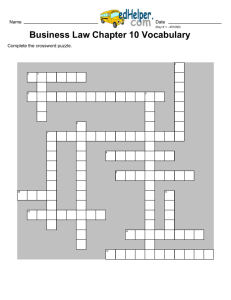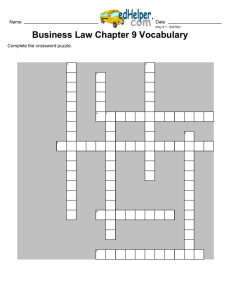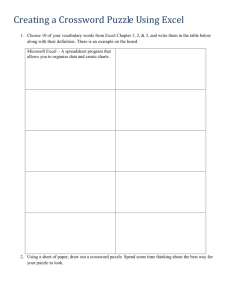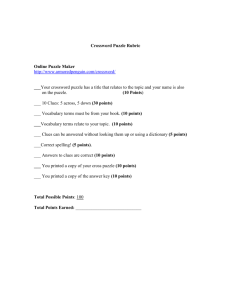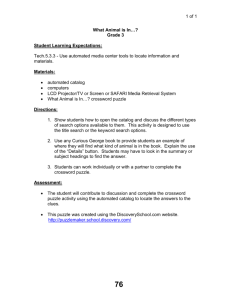C1 Water Cycle - Minnesota Nursery and Landscape Association
advertisement
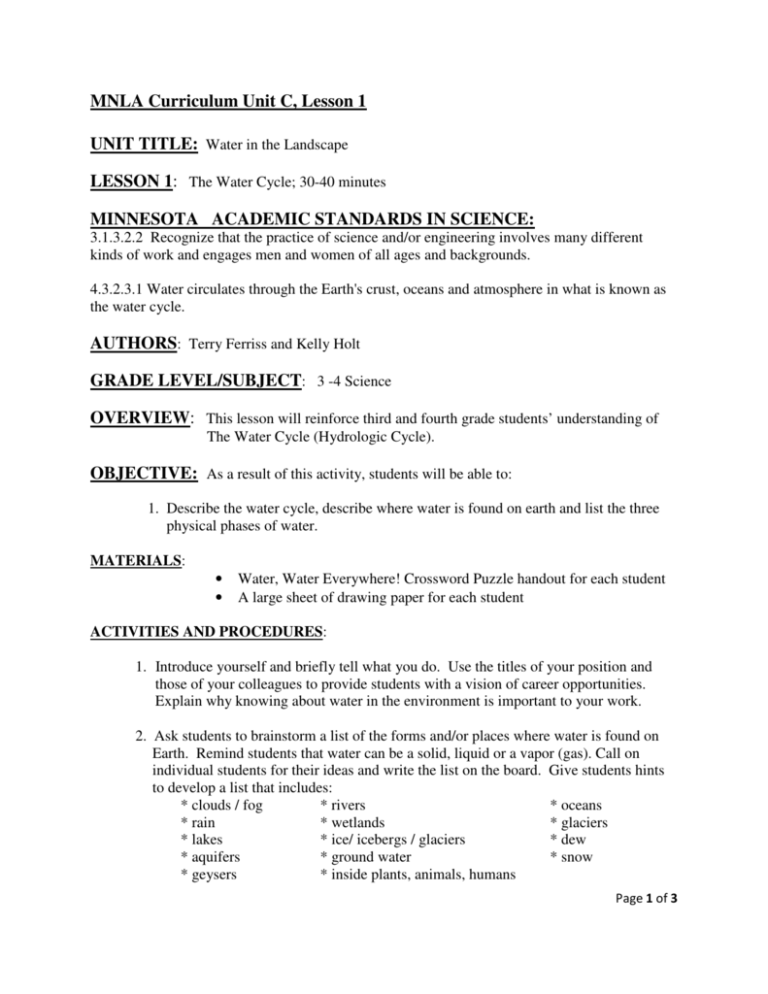
MNLA Curriculum Unit C, Lesson 1 UNIT TITLE: Water in the Landscape LESSON 1: The Water Cycle; 30-40 minutes MINNESOTA ACADEMIC STANDARDS IN SCIENCE: 3.1.3.2.2 Recognize that the practice of science and/or engineering involves many different kinds of work and engages men and women of all ages and backgrounds. 4.3.2.3.1 Water circulates through the Earth's crust, oceans and atmosphere in what is known as the water cycle. AUTHORS: Terry Ferriss and Kelly Holt GRADE LEVEL/SUBJECT: 3 -4 Science OVERVIEW: This lesson will reinforce third and fourth grade students’ understanding of The Water Cycle (Hydrologic Cycle). OBJECTIVE: As a result of this activity, students will be able to: 1. Describe the water cycle, describe where water is found on earth and list the three physical phases of water. MATERIALS: • • Water, Water Everywhere! Crossword Puzzle handout for each student A large sheet of drawing paper for each student ACTIVITIES AND PROCEDURES: 1. Introduce yourself and briefly tell what you do. Use the titles of your position and those of your colleagues to provide students with a vision of career opportunities. Explain why knowing about water in the environment is important to your work. 2. Ask students to brainstorm a list of the forms and/or places where water is found on Earth. Remind students that water can be a solid, liquid or a vapor (gas). Call on individual students for their ideas and write the list on the board. Give students hints to develop a list that includes: * clouds / fog * rivers * oceans * rain * wetlands * glaciers * lakes * ice/ icebergs / glaciers * dew * aquifers * ground water * snow * geysers * inside plants, animals, humans Page 1 of 3 3. Explain/review the water cycle (hydrologic cycle) while drawing representative images on the board and using all of the water forms developed in the previous list. As an alternative to drawing, locate an image of the water cycle from a web site source such as Google images, MN DNR or the US Geological Survey and show a printed version. Describe the potential path of a raindrop starting with a cloud: cloud evaporates into clouds / fog condenses to rain trickles through soil / ground water ocean Lake / river up through a spring / geyser or pumped aquifer Repeat the explanation of the water cycle, but now add the role of plants and animals in the cycle. Explain how plants lose water through evaporation and the water is once again vapor in the clouds. 4. Share with the students the following facts from the U.S. Geological survey. • 75% of the earth is covered with water; 25% is land • 97% of the earth's water is in the oceans-its saltwater (humans can't drink it) • Only 3% of the earth's water is freshwater-water without salt • Almost 99% of freshwater is ice or in the soil • The 1% of freshwater available to people is in rivers, lakes, wetlands and aquifers • Water is a limited resource. There is a given amount of it and we can't make more • Evaporation: sun heats water and turns water into a vapor or steam • Condensation: water vapor in the clouds gets cold and changes back to a liquid • Precipitation: water condenses in the air and falls to the Earth's surface Page 2 of 3 5. Students should complete the Water, Water Everywhere Crossword puzzle individually or in small groups. Ask the teacher what would be most appropriate. 6. Provide a large sheet of drawing paper for each student and ask the students to draw a diagram of the water cycle. Encourage students to think about all the places where water is found on earth and the path of the raindrop. It may be helpful to first provide an example of what to draw. Extension / Optional Activity: Provide students with a variety of art supplies to enhance their drawings of the water cycle. Examples: • cotton balls for clouds • cosmetic cotton pads for ice/glaciers • blue sequins for raindrops • blue celophane for lakes and rivers • pipe cleaners or dry tubular macaroni for water pipes ASSESSMENT: Students will complete the Water, Water Everywhere Crossword puzzle to demonstrate their understanding of the terminologies associated with the water cycle. Students will demonstrate their understanding of the water cycle by drawing a diagram of the water cycle. HANDOUTS AND WORKSHEETS: • Water, Water Everywhere Crossword puzzle handout Page 3 of 3
